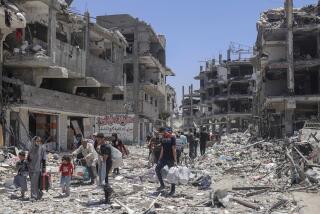Chertoff Differs With the Military
- Share via
WASHINGTON — Homeland Security Secretary Michael Chertoff said Monday that, if the military were deployed inside the United States in response to a terrorist attack, his department -- not the Pentagon -- would exercise overall control.
“The Department of Homeland Security has the responsibility under the president’s directives to coordinate the entirety of the response to a terrorist act here in the United States,” Chertoff said on CNN, responding to news reports that the Pentagon has drawn up plans for military action.
The Washington Post reported Monday that the Defense Department has a series of classified plans for the role it might play in scenarios that range from crowd-control assignments to dealing with a radiological or biological attack. The article quoted Adm. Thomas J. Keating, head of the Northern Command, as saying: “[In the event of] a biological, chemical or nuclear attack in any of the 50 states, the Department of Defense is best positioned -- of the various eight federal agencies that would be involved -- to take the lead.”
The report said the Pentagon planning encompassed 15 possible scenarios. In an attempt to prepare for multiple strikes, like those seen in the July 7 bombings in London, some scenarios envisioned coordinating responses to as many as three different attacks occurring simultaneously, the Post reported.
The story raised concern about possible plans for declaring martial law, since the military is forbidden to take part in domestic law enforcement under the Posse Comitatus Act of 1878. Some analysts questioned whether the plans signaled a historic shift for the Pentagon.
But Article 2 of the Constitution, which designates the president as commander in chief of the armed forces and charges him with protecting the nation, theoretically allows him to deploy troops inside the United States. Actions authorized by the Constitution do not fall under the Posse Comitatus Act.
The use of military troops under civilian authority in times of emergency has a long history -- for example, in the aftermath of numerous natural disasters.
Security specialists outside the government said the plans reported by the Post did not appear to mark a substantive break with past practice.
“The responsibility is at the local level, and the state and federal assets that come are in support,” said James Jay Carafano, a senior research fellow at the Heritage Foundation, a Washington think tank. “In 9/11 [New York Mayor Rudolph W.] Giuliani was the guy in charge.”
Chertoff acknowledged that although civilian control would be maintained, the military would have a vital role in responding to any major attack.
“Obviously the Department of Defense has certain capabilities, including the ability to put a lot of hospitals and a lot personnel in the field, which would be critical if we had a truly mass event,” Chertoff said on CNN’s “The Situation Room.”
He added that the National Response Plan, created to help the federal government and its various agencies deal with domestic emergencies, relied on a team approach that gave different agencies leading roles depending on the type of problem. In the event of a biological incident, for example, the Department of Health and Human Services would take the lead.
Throughout any domestic emergency, Health and Human Services would play the role of quarterback, organizing and directing the response, Carafano said.
Pentagon officials in the past have stressed that in any emergency situation in which the military was deployed, it would work to back up local and state authorities. In June, the Pentagon issued a domestic defense strategy underscoring that civilian law enforcement had primary responsibility for domestic law enforcement.
The Post report about the contingency plans comes at a time when the Pentagon is conducting a yearlong internal review of weapons systems and force levels in an attempt to balance the post-Sept. 11 demands of domestic defense against commitments overseas.
The plans are detailed in two documents put together by the Northern Command, the newspaper reported. Created in October 2002 to coordinate military activities throughout the United States, Northcom has a staff of about 640. It monitors ship and air traffic, the nation’s borders and can track large gatherings like the National Scout Jamboree in Virginia, or events like the Discovery shuttle launch, all from its base in Colorado Springs, Colo.
To some extent, planning for a Pentagon role in responding to a terrorist attack merely reflects the fact -- as Chertoff said -- that it has resources that go beyond the capabilities of local public safety and law enforcement agencies.
Though some civil liberties groups have raised concerns about the military plans, Carafano argued that these larger capabilities made them necessary.
“If the military shows up, it means there will really be lives and property at stake and people will be cheering when they show up,” he said. “And if things are bad enough that they have to call out the military, the credibility of the government will be on the line and then it’s even more important that they have planned for it. The last thing you want is an ad hoc response.”
More to Read
Sign up for Essential California
The most important California stories and recommendations in your inbox every morning.
You may occasionally receive promotional content from the Los Angeles Times.













